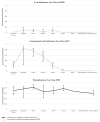Polysubstance Use among Maryland High School Students: Variations across County-Level School Districts
- PMID: 38791853
- PMCID: PMC11121598
- DOI: 10.3390/ijerph21050639
Polysubstance Use among Maryland High School Students: Variations across County-Level School Districts
Abstract
Background: Polysubstance use is a highly prevalent public health issue, particularly among adolescents, and decisions on prevention programming and policies are often made at the local level. While there is a growing literature examining patterns of polysubstance use among adolescents, little is known about differences in those patterns across geographic regions.
Methods: Using a large, representative sample of high school students from the state of Maryland (n = 41,091) from the 2018 Maryland Youth Risk Behavior Survey, we conducted a latent class analysis (LCA) of adolescent substance use along nine binary indicators, including past 30-day combustible tobacco, e-cigarette, alcohol, and cannabis use, as well as lifetime use of prescription opioids, cocaine, heroin, methamphetamine, and injection drug use. Measurement invariance across counties was examined using the Multiple Indicators and Multiple Causes (MIMIC) procedure.
Results: The results of the LCA show three classes of adolescent substance use for the total sample: (1) low substance use, (2) commonly used substances (i.e., e-cigarette, alcohol, and cannabis use), and (3) polysubstance use. The results from the MIMIC procedure demonstrated geographic differences in students' endorsement of specific indicators and their class membership.
Conclusions: These differences demonstrate the need for an examination of local trends in adolescent polysubstance use to inform multi-tiered prevention programming and policy.
Keywords: adolescence; county; polysubstance use; prevention; school districts.
Conflict of interest statement
The authors declare no conflicts of interest.
Figures


Similar articles
-
Using Latent Class Analysis to Examine Polysubstance Use Patterns in Adolescents Aged 10-18: A Systematic Review.Addict Behav. 2025 May;164:108281. doi: 10.1016/j.addbeh.2025.108281. Epub 2025 Feb 6. Addict Behav. 2025. PMID: 39954664
-
Characterizing profiles of polysubstance use among high school students in Baltimore, Maryland: A latent class analysis.Drug Alcohol Depend. 2020 Jun 1;211:108019. doi: 10.1016/j.drugalcdep.2020.108019. Epub 2020 Apr 25. Drug Alcohol Depend. 2020. PMID: 32354578 Free PMC article.
-
Grade-Level Differences in the Profiles of Substance Use and Behavioral Health Problems: A Multi-Group Latent Class Analysis.Int J Environ Res Public Health. 2024 Sep 10;21(9):1196. doi: 10.3390/ijerph21091196. Int J Environ Res Public Health. 2024. PMID: 39338079 Free PMC article.
-
High-School Students Rarely Use E-Cigarettes Alone: A Sociodemographic Analysis of Polysubstance Use Among Adolescents in the United States.Nicotine Tob Res. 2021 Feb 16;23(3):505-510. doi: 10.1093/ntr/ntaa037. Nicotine Tob Res. 2021. PMID: 32052052
-
A Scoping Review of Gender, Sex and Sexuality Differences in Polysubstance Use in Adolescents and Adults.Alcohol Alcohol. 2022 May 10;57(3):292-321. doi: 10.1093/alcalc/agac006. Alcohol Alcohol. 2022. PMID: 35284931 Free PMC article.
Cited by
-
Using Latent Class Analysis to Examine Polysubstance Use Patterns in Adolescents Aged 10-18: A Systematic Review.Addict Behav. 2025 May;164:108281. doi: 10.1016/j.addbeh.2025.108281. Epub 2025 Feb 6. Addict Behav. 2025. PMID: 39954664
References
MeSH terms
Grants and funding
LinkOut - more resources
Full Text Sources
Medical
Research Materials
Miscellaneous

